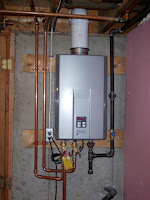Monday, November 29, 2010
A Great Start
Thank you Priya for sharing this lovely award with me. Hearty Congratulations to the other bloggers who have received blog awards. I would like to extend a very big thanks to all the fellow bloggers who have constantly supported me and have been so very encouraging. For new bloggers like me who have just started off into the blogging world it is very exciting and very encouraging to get nice comments and awards. Thank you all again. All of you have a great week ahead. Take care.
Better get yours while the "gettin' is good"
Do you have a home?
All homeowners in the United States are eligible for this 30% credit for every dollar you spend with a limit of $1500.00. With a wide range of opportunities to turn your home into a monument of efficiency, acting now could also save you a few bucks immediately. Home heating systems and water heaters are the seasonal choice as the snow falls and we are now spending more time indoors. Imagine lowering your heating bill by 10-25%!
How Products Earn Energy Star Ratings
 The Energy Star Label Takes The Guesswork Out of Shopping for Energy Efficient Heating & Cooling Equipment!
The Energy Star Label Takes The Guesswork Out of Shopping for Energy Efficient Heating & Cooling Equipment!With so much emphasis on improving energy-efficiency, minimizing utility bills and reducing our reliance on fossil fuels, the Energy Star seal has come to the forefront of the environmentally (and fiscally) responsible homeownership movement. But what exactly is the Energy Star program and how does a product receive the Energy Star endorsement?
What is Energy Star?
Energy Star is a program sponsored by the federal government that tests, reviews, and certifies major home appliances, equipment and entertainment devices for energy efficiency -- including HVAC equipment such as furnaces and air conditioners. The main goals of the Energy Star program are to help consumers save money on utility costs and to reduce our impact on the environment.
The Energy Star program was established to cut down on greenhouse gas emissions and pollutants released when fossil fuels are burned to produce energy. The Energy Star program is also aimed to make it easier for consumers to shop for and purchase products that are better for the environment without sacrificing quality, performance, and state-of-the-art features.
How Does the EPA Determine a Product’s Energy Star Eligibility?
The Environmental Protection Agency (EPA) sets forth Energy Star efficiency standards and grants the label to products that meet these requirements. The EPA has developed the Energy Star specifications based on a set of key principles:
- Product categories must contribute substantial energy savings in most areas of the country.
- Products must deliver both features and performance customers want, as well as demonstrated energy efficiency.
- If the product is more expensive than comparable, less efficient models, buyers must be able to recoup the initial investment in energy efficiency through savings on utility bills in a reasonable length of time.
- Energy efficiency is achieved through readily available, non-proprietary technology offered by an array of manufacturers.
- The energy consumption and performance of the product must be able to be measured and confirmed with testing.
- Affixing the Energy Star label would effectively set products apart and make them more visible to consumers.
Does the EPA Ever Revise Energy Star Requirements?
Usually, when the market share of Energy Star rated products in a particular category -- such as refrigerators, televisions, or dishwashers -- reaches 50 percent or more, the EPA will consider revising standards in that category. Such market saturation indicates that manufacturers are easily able to comply with Energy Star specifications and that perhaps the requirements are not as stringent as they could be. This will usually prompt the EPA to take a closer look at categorical qualifications and make changes if necessary.
Some other factors that may impact a decision to revisit Energy Star specifications include:
- Adjustments in the federal government’s minimum standards for energy efficiency
- Technological advances in energy efficiency that would result in even greater energy savings if Energy Star ratings were changed
- Availability of products
- Substantial problems with consumers’ expected energy savings or inconsistencies with promised savings
- Quality or performance issues
- Problems with research or testing procedures
How Reliable are Energy Star Ratings?
Because the EPA reviews Energy Star specifications frequently, you can trust that purchasing an Energy Star rated appliance or other device ensures that you’re getting an efficient, money-saving product. The next time you’re in the market for an electronic device, shop the Energy Star label and you may be pleasantly surprised by your next utility bill.
This is especially true with HVAC (Heating, Ventiliating and Cooling) equipment. Today's heating and air conditioning systems are much, much more energy efficient than those made just 10 years ago. When you purchase and install heating and air conditioning equipment that carry the Energy Star seal, you can be confident that they not only meet but exceed the government's requirements and recommendations for energy efficiency ratings.
Horizon Services is proud to sell and install only Energy Star rated heating and cooling equipment furnaces, air conditioners, heat pumps, boilers and water heaters. Contact Horizon Services today to discuss Energy Star rated equipment from many of the industry's most trusted HVAC manufacturers including: Lennox, Trane, Rheem, York, Comfortmaker, Janitrol, American Standard, Carrier and Bryant.
Related Information from Horizon Services...









